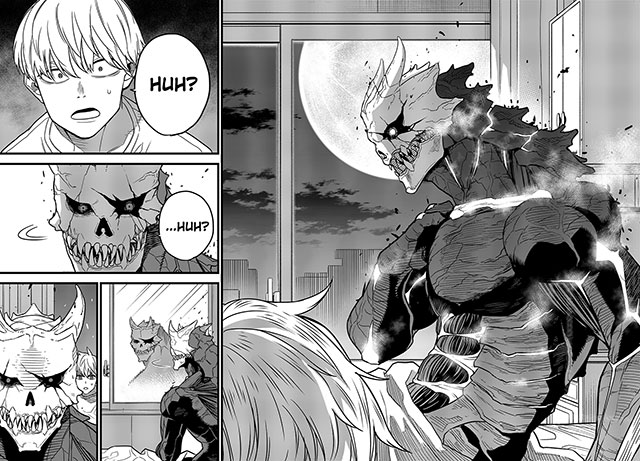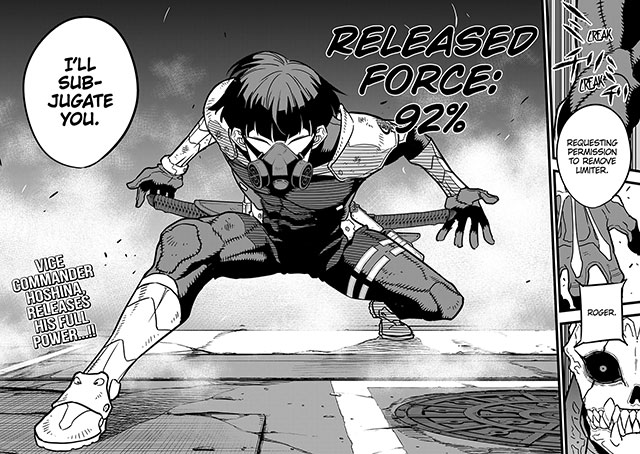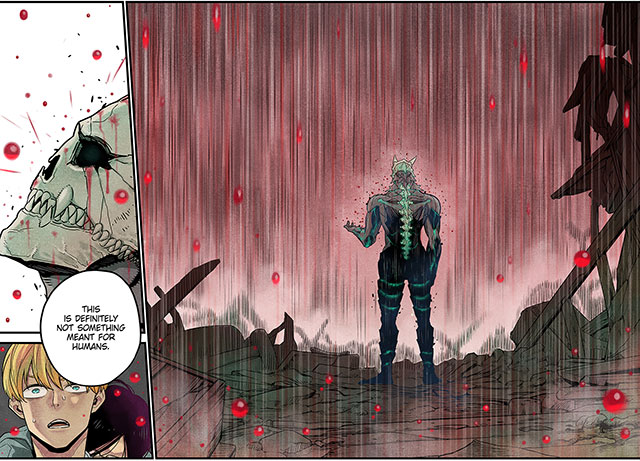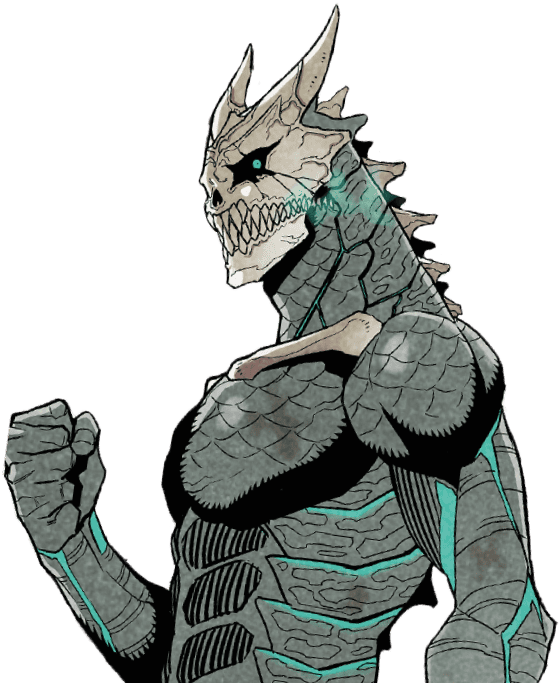The birth of
KAIJU NO.8 (Monster #8)!
── Please tell us how KAIJU NO.8 (Monster #8) came to be.
Nakaji: This is Matsumoto’s third serialization, but for a while, after the previous work was completed, we had multiple meetings to create a new story from scratch. I would make suggestions, and Matsumoto would come up with ideas too. The result of these long discussions was KAIJU NO.8 (Monster #8). When Matsumoto asked me, “How about this?” he had already completed chapter 1. It was very unexpected since he had previously done more fantasy works. I think he always wanted to draw a superhero story, but the biggest reason was that his emotions were well reflected in the main character, Kafka. Matsumoto is the kind of person who starts drawing only after he has completely formulated the worldview in his mind, so in that sense, too, I think it was a really good fit.
── How did you develop the portrayal of the main character as a hero who conceals a hidden monster inside, whilst defeating monsters?
Nakaji: Matsumoto had always loved tokusatsu*, and he particularly liked the protagonist archetype seen often in the genre—where individuals gain extraordinary abilities, and become a hero, but also bear the weight of inner struggle as a consequence. Conceptually, it feels somewhat akin to antiheroes in American comics. In terms of visuals, the design explores a combination of fear and coolness. The current Monster #8 is inspired by oni** and skulls, resulting in a somewhat eerie yet finely balanced visual that makes it hard to determine if it leans towards the side of justice or evil. Personally, I feel that Monster #8 differs significantly from the protagonists Matsumoto has depicted in the past. Kafka carried an atmosphere that linked to Matsumoto when he was first creating the character. I believe this adds an extra layer of passion to the work.
*Tokusatsu: Japanese live-action films and TV series characterized by extensive use of practical effects, typically featuring superheroes and monster stories.
**Oni: A kind of Japanese yokai, akin to a demon, ogre, or troll.
── In KAIJU NO.8 (Monster #8) there are many expressions that evoke images of disasters. Is there a reason for this?
Nakaji: In this series, monsters (kaiju) are portrayed in a context similar to natural disasters such as typhoons and earthquakes. The emergence of monsters in this world is akin to the inevitability of unpredictable and unavoidable natural calamities. To make it easy to visualize, even the indicators of the monster’s strength are aligned with actual units.
── It’s a very realistic setting, distinct from typical science fiction.
Nakaji: KAIJU NO.8 (Monster #8) isn’t science fiction, but rather, it portrays a world that is an extension of the everyday world we currently live in. The only difference from reality is that instead of natural disasters, monsters appear. It’s not a futuristic, fictional world but rather one that closely resembles present-day Japan. To emphasize this, Japanese motifs like shopping districts and swords are deliberately incorporated. Matsumoto has a rule that “there is only one lie per story. ” In the case of KAIJU NO.8 (Monster #8), the existence of monsters is the big lie. While settings related to this lie, such as the Defense Force and monster cleanup crew are introduced, additional elements like “humans can use magic” are intentionally avoided. This makes it more relatable and acceptable for readers.
── At the start of serialization, what were your thoughts on the direction and future developments of the work?
Nakaji: We had considered two directions. One where Kafka leads a normal life while hiding his true identity, and the other where he pursues his dream even after becoming a monster. Either way, it would’ve resulted in entirely different stories, but based on Matsumoto’s wishes, the current direction was chosen.
── From your point of view, what are the key points of interest and strengths of KAIJU NO.8 (Monster #8)?
Nakaji: I believe a major appeal of KAIJU NO.8 (Monster #8) lies in its overwhelming readability and clarity, making it accessible to readers of all ages. Matsumoto is extremely conscious of wanting people to read it, and he puts a lot of thought into achieving that goal. One approach is putting “hooks” at the beginning. It incorporates a structure where it plants intriguing information in the reader’s mind to pique their interest at the beginning, gradually revealing more details. Taking the first chapter as an example, the opening scene showcases a formidable monster before delving into the explanation of the world, which is the embodiment of this narrative structure. By doing so, it captivates readers, creating a mechanism where they are eager to know what happens next. I encourage you to find these subtle techniques as you read each chapter.
── It’s a structure where even those unfamiliar with manga will find easy to delve into.
Nakaji: I believe that it’s thanks to this structure that many people read the work. In terms of strengths, I think the high level of empathy in the characters stands out. Not just Kafka, but each of the other troop members carries their own burdens and is working hard within the given circumstances. I’m sure there are many who can resonate with their struggles. I hope you find a character to empathize with and come to love.
── Many characters seem to have a consciousness of “doing it for someone else.” Is there any particular connection or reason for this?
Nakaji: Characters become more appealing within their relationships, so I am conscious of creating depth in the emotions they harbor towards others and the impact it has. For instance, there's the emotion of fighting “for the sake of a senior (Kafka)” like in the case of Leno, and I also find value in portraying negative emotions. Take Iharu, for example. He initially thought of Leno as inferior, but as Leno steadily surpasses him, he develops a strong sense of inferiority. This is something everyone experiences in the process of growth. I make an effort to meticulously depict how such relatable emotions and the sentiments held interact for each character.
The process of creating the story!
── Can you tell us how you conduct each meeting and what you often discuss at meetings?
Nakaji: We have meetings about once every two weeks, mainly after the final draft has been submitted. Since the overall storyline is already established, our discussions center more on what ideas to incorporate within each chapter rather than determining the plot progression. This involves considerations for visual appeal, scene creation, and directing choices. Given that an individual’s creative repertoire is inevitably limited, my role involves exploring ways to add elements to Matsumoto’s ideas. Among these considerations, what I value most is how to present the sequence of events in the story in an engaging manner. Simply adhering to the traditional narrative structure can result in a predictable plot, making it very ordinary. Additionally, I pay attention to how to highlight key moments in each episode, similar to the feeling of movie editing. Matsumoto thoroughly thinks through any aspects where he feels there might be a mismatch with my ideas, making our meetings very collaborative and easy to conduct.
── In terms of the story’s development, does it often progress as planned?
Nakaji: Not necessarily. While we discuss the rough flow of each series beforehand, sometimes things that sound interesting in conversation don’t translate well into manga, leading to quite a few changes. You never really know how the characters will act until you start drawing. If the development takes a different turn, I think about new twists and turns from there. It’s a continuous process of refining the overall concept and the specifics.
── Do you draw inspiration from other works?
Nakaji: Absolutely. I make sure to share anything I find interesting, not only in manga but also in movies and anime. The effect of light shining through the muscles in Monster #8’s body was to make his movement look cool, and was inspired by the movie “Tron.” So, in that way, I often draw inspiration not only from the content but also from the visual aspects as well.

The unique visual of light shining between muscles adds to its mysterious allure, creating a powerful impression!
── Is there a specific visual aspect that Matsumoto-sensei particularly focuses on?
Nakaji: He’s quite particular about readability. Since it’s published digitally, he aims for a layout that is easy to read even on smartphone screens and can stand out as a single page. Creating manga in the traditional print format makes readability a challenge for dialogue and intricate details on smartphone screens. Being able to consider these aspects while creating the work reflects a high level of skill.
── How do you go about crafting the distinct personalities and fighting styles for the variety of characters?
Nakaji: We often create them based on their personalities. Of course, visual considerations play a role too. For example, I wanted a cool weapon for Narumi, so I conveyed the somewhat vague image of a bayonet I had in mind through illustrations. Matsumoto then refined it, taking on its current form.
── It’s an unavoidable aspect of the story that many people suffer, given the theme of disasters. Are there any considerations or efforts made for the readers?
Nakaji: Since disasters are a major plot point, there are inevitably parts that can’t be avoided, but Matsumoto has mentioned, “I don’t want to unearth someone’s trauma. ” He tries not to depict overly cruel scenes and introduces elements like the existence of shelters in the story. The premise is to convey that there are preparations in place to respond to emergencies.
About Matsumoto-sensei!
── Can you share with us Matsumoto-sensei’s hobbies and personality?
Nakaji: You might have guessed, but he likes “Jump” manga. I think “Dragon Ball” was what inspired him to become a manga artist. On the contrary, I lean more towards seinen magazines, so our tastes might not align (laughs). Perhaps that’s why we don’t talk about our favorite manga as much. Personality-wise, he’s a genuinely bright, serious, and fashionable person. He’s determined, but also flexible, readily incorporating things he finds appealing.
── KAIJU NO.8 (Monster #8) has a very different setting from the previous work “Pochi & Kuro,” what motivated you to work on a project with such a drastic change in genre?
Nakaji: During the serialization of “Pochi & Kuro,” I felt that it was challenging to sell fantasy works online. Around that time (around 2014), web manga consisted largely of older-style seinen works, and fantasy struggled to gain popularity. I think if I were to do “Pochi & Kuro” now, there might be a different response. However, Matsumoto had lingering frustration from that time, leading to a drastic change in genre with KAIJU NO.8 (Monster #8).
── From your perspective, could you share Matsumoto-sensei’s changes and growth from debut to the present?
Nakaji: I think his thought process has become incredibly solid. He’s shifted from wishful thinking to a more technical approach, consistently asking, “How can I get people to read this?” The structure I mentioned earlier, designed to make the work more readable, stems from this mindset. I get the impression that there’s been a gradual refinement from debut to now. I believe the extensive study and discussions during his assistant days played a significant role. It’s quite rare to find someone who can transform logically reasoned ideas into genuinely engaging manga. The results of his diligent accumulation of skills are evident in KAIJU NO.8 (Monster #8). It’s truly impressive.
There’s more to come for
KAIJU NO.8 (Monster #8)!
── As the editor in charge, could you tell us about your favorite character?
Nakaji: My favorites are Hoshina and Iharu. Hoshina may seem like a carefree and strong individual at first glance, but he actually harbors some self-confidence issues and is remarkably loyal to those who need him. Yet, when it comes to battling monsters, a hint of madness becomes apparent. I like characters with that kind of complexity. One of my favorite scenes of Hoshina is when he has a one-on-one duel with Monster #8. We put a lot of emphasis on pacing in this scene. Hoshina initiates an attack, creating an instant surge of tension, and then his striking battle stance is revealed. Interestingly, we rearranged the cuts before and after this moment, and it made it the perfect pacing for the scene. Coincidentally, this scene was released just when the first volume of the manga was published. The positive reception to this confrontation significantly boosted the sales of the first volume. With such memories attached, this scene is a personal favorite of mine, and I hope it becomes memorable for readers too.

The excellent tension and pacing of the battle between Hoshina and Monster #8!
Another favorite of mine, Iharu, harbors a simple inferiority complex toward Leno. I find myself loving characters like that. It’s not just about jealousy; it’s the ability to dive into things with a determination not to be defeated. I think that’s incredibly courageous, and I admire it. Also, characters with expressive emotions are easy to maneuver in the story, so that’s quite convenient (laughs).
── Are there other scenes you’d like to highlight?
Nakaji: The scene in chapter 2 after Monster #8 defeats a monster and stands in the blood rain. My theory is that, when it comes to action scenes, it’s not just about the action itself but also about what happens before and after. While the fights are undoubtedly cool and captivating, what often sticks in your memory after reading is the stance before the battle or a memorable line, right? To leverage this principle and utilize the digital platform, I wanted to create a strong impact by adding a striking colored image after the monster was defeated. Digital series tend to experience a drop in engagement from the first to the second chapter. To counteract this, we created this scene, and I feel like the setup worked well.

KAIJU NO.8 (Monster #8) utilizes the digital platform to enhance the storytelling.
── The scene where Kafka and Leno jump out of the hospital window in the second chapter is also very impressive.
Nakaji: Yes, that moment is used to highlight the difference in physical abilities between humans and monsters by showcasing Kafka and Leno’s difference in jumping power. Embedding such information within scenes is quite common, and throughout many other scenes, Matsumoto has incorporated unique ideas of his own.
── What are your future plans and goals for KAIJU NO.8 (Monster #8)?
Nakaji: First and foremost, the primary goal is to successfully complete the series in a way that satisfies Matsumoto. Additionally, a new serialization “Kaiju No. 8: B-Side”, a novel-to-manga adaptation will begin on “Shonen Jump+”. This series will focus on squad members other than Kafka, such as Hoshina and Kikoru, offering a different perspective on the world of KAIJU NO.8 (Monster #8). I hope you’ll enjoy them both.
── Could you share what to anticipate in the upcoming April anime and your thoughts on it?
Nakaji: I saw the storyboard, and I was just overwhelmed, thinking, “It’s unbelievable how amazing it has become in the hands of a professional!” Certain aspects that were compressed in the manga, were further explored or reinterpreted. I’m also really looking forward to seeing how the action moves and the colors of the monsters turn out. Moreover, since the anime will be simultaneously streamed worldwide, people from all over the world can enjoy it together. I hope many people will join in on the excitement.
── As an editor, what do you think is necessary for a work to be loved and appreciated for a long time?
Nakaji: I believe it’s crucial to meet the expectations of the readers and create beloved characters. Matsumoto often expresses the desire to create works where readers feel like they are visiting their favorite characters. When collecting comics, you might notice that people say they read a particular volume because their favorite character is prominently featured. The feeling of growing fond of someone tends to endure, so I think works that make readers want to revisit them to “visit” those characters are the ones that are loved for a long time.
──Lastly, do you have a message for the readers of MANGA Plus?
Nakaji: The story is going to become even more heated. You can read the latest chapters on MANGA Plus, so I hope you’ll read it in real-time, share your thoughts with other readers, and engage in discussions. Thank you for always reading KAIJU NO.8 (Monster #8).


Q1 Has anything changed in terms of writing between when you started KAIJU NO.8 (Monster #8) and now?
Matsumoto: The location of my workplace changed. At the beginning of the series, I was drawing in the area under the jurisdiction of the Third Unit. As the story switched to focusing on the First Unit, I also moved to the First Unit’s area. I’m glad I moved because some differences became apparent after living there.
Q2 Can you tell us the characters you currently enjoy drawing and which ones you struggle with?
Matsumoto: I enjoy depicting hand-to-hand combat, so the characters I find fun to draw are Kafka, Kikoru, and Hoshina. The character I have a hard time drawing is the monster Kafka. It takes me a long time to draw him, so when Kafka transforms, my drawing time increases significantly.
Q3 Do you have a favorite scene?
Matsumoto: It would be chapter 7 when Kafka rushes to Kikoru, who had put up a really good fight. I remember crying as I drew the scene where he says “You did an amazing job, Kikoru!!”
Q4 Is there anything in particular you focus on when it comes to framing and panels?
Matsumoto: I try to direct the reader’s eyes naturally toward key elements, such as the characters’ faces and speech bubbles as much as possible. Consequently, I avoid using overly extravagant panel layouts or framing.
Q5 There are many unique monsters in the series, but how are the monsters designed?
Matsumoto: I sometimes draw inspiration from the fantastic monsters and creatures created by predecessors. Additionally, I often use animals, insects, and plants as motifs. I also find inspiration in art and fashion.







